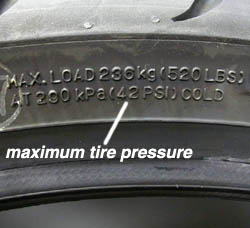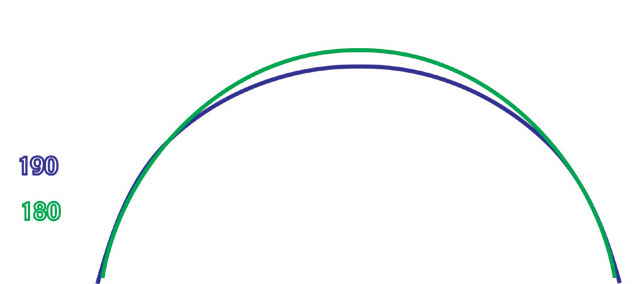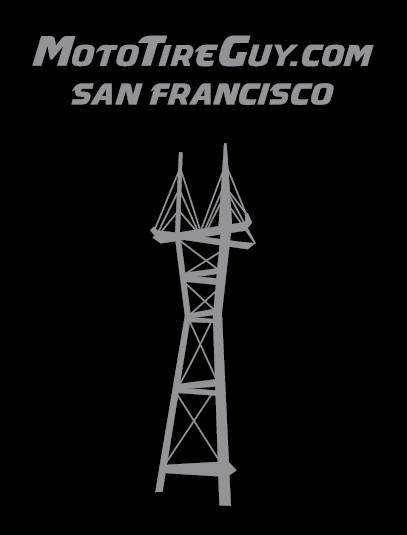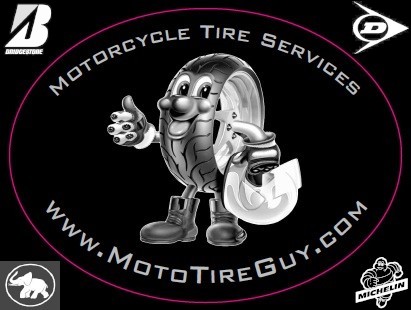Translation - ▄bersetzung
- Traducciˇ - Перевод
- 翻译 - الترجمة - แปล
Motorcycle Tire FAQ
(Frequently Asked Questions)
Motorcycle Tire Services
1064 Revere Avenue - San Francisco, CA 94124
415.601.2853
◊ Tire
Pressures◊
Motorcycle tire
pressure maintenance is very important! Check and monitor your tire
pressures at least every other month. It's normal for all pneumatic tires
slowly lose some air pressure regardless of the
bike being parked or in use. Riding on under inflated or over inflated tires
results negatively impacts on tire performance and rider safety. So if you haven't checked for a long time you could be
running low.
The tire pressure
information stamped on the sidewall every DOT approved tire is the maximum
tire pressure. I recommend you only use the indicated maximum pressure if you
ride a very heavy touring motorcycle or carry a very heavy passenger. Do not
exceed this maximum pressure. For accuracy measure the tire pressures when
tires are cold.
In general terms
lightweight 250 pound dirt bikes typically use tire
pressures in the 15psi range. Lightweight 300 pound
bikes typically use tire pressures in the 25psi range. Middle weight 400 pound standard/sport bikes typically use tire pressures
in the 35psi range. Large heavy weight +600 pound
touring bikes typically use tire pressures in the 40psi range.

◊ Tire Age
- Manufacture Date ◊
Every US
Department Of Transportation approved automotive and
motorcycle tire has the tire birth date stamped tire sidewall. Look for the
last numbers following the DOT codes. The format of this date appears in a WWYY
format, as in week/year. For example the manufacture
date code of 4407 translates to the 44th week of 2007. Tires produced prior to
the year 2000 use a three digit code. For example the manufacture date code of 378 translates to the
37th week of 1998.
Rubber products
do not improve with age. Years of sunlight, ozone, heat cycles, road salts,
chemicals, wear and tear all take their toll on
healthy tires. The rubber slowly become more brittle/slick and loses the good
road gripping sticky qualities we depend on. In some cases
you maybe begin to see small cracks developing in the tire tread or the tire
sidewalls or in the tread grooves.

◊ New Tire
Break-In Procedure ◊
Beware, new tires
are slippery! Always ride slower than normal and use abundant caution when
first riding on brand new motorcycle tires or you risk slide and/or crash. New
tires need to 'heat-cycle' a couple of times before they can begin to offer
100% of available grip. This break-in procedure is typically accomplished after
the first 50 turns and 50 miles of use. Using sandpaper on a new tire in an attempt to accomplish break-in process does not work.
◊ Tire
Sizes - Is Bigger Better? ◊
A wider than
stock tire is NOT automatically the improvement you might think. The 'best'
tire size is most often the stock tire size. When you try to install a wider
tire the same size wheel the optimal shape/profile of the tire becomes
distorted which can result in abnormal steering character and abnormal tire
wear. If you really want a wider tire the right way to get there is to match
the wider tire with a corresponding wider wheel.
In the
illustration below you can see what happens when you try to mount a 190/50/17
size tire on a 5.5x17" wheel normally designed for 180/55/17 size tires.

◊ Tire
Repairs - Plug/Patch ◊
There are two
types of puncture repairs for tires. Outside-In plugs (temporary) and permanent
Inside-Out plugs (permanent).
The most common
on the road tire fix is the outside-in repair. These repair kits typically
include a specialized piece of sticky rope or a mini-mushroom type plug. This
outside-in type of repair does not require removing the tire from the wheel and
is applied from the outside of the tire. This type of repair is considered temporary,
allowing the rider to limp the bike back home or to a service shop where a
proper inside-out repair can be done or by having a new tire installed.
The other more
'approved' long term repair method is the inside-out repair. This method is not
easy to do on the side of road because it requires removing the tire from the
wheel, drilling out the hole to a more uniform size and installing the
plug/patch from the inside of the tire. I use the Uni-Seal 250UL plugs. This is
the only 'approved' method for proper and permanent repairs of tire punctures.
Tire Slime
inflate-a-flat type products are an alternate method for temporary tire repairs.
This method is also a temporary fix. Used long term these tire slime products
can cause corrosion to the inside of alloy wheels. Please warn the tire
technician if you have slime inside your tire before they begin work. Tire
slime makes a mess when you remove the tire.
All tire repairs
affect the maximum speed rating of the tire. Repaired tires are not approved
for speeds over 70mph. If you are running an inner tube type tire these plug
repairs do not work. A new or patched inner tube is required.

* California
residents who purchase tax free products from outside of California are
encouraged to report these purchases on their state tax returns under Use
Tax.
Aprilia, BMW, Cagiva, Ducati, Honda, Husaberg,
Husqvarna, Hyosung, Kawasaki, KTM, Moto Guzzi, MV Agusta, Norton, Suzuki, Triumph, Yamaha
Alameda,
Berkeley, Brisbane, Burlingame, Colma, Cupertino,
Daly City, Fremont, Foster City, Hayward, Hillsborough, Hillsdale, Marin,
Millbrae, Milpitas, Mountain View, Oakland, Pacifica, Palo Alto, Redwood City,
San Bruno, San Carlos, San Jose, San Leandro, San Mateo, San Rafael, Sausalito,
Sonoma, South San Francisco, Sunnyvale
